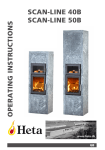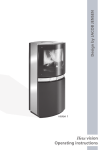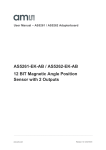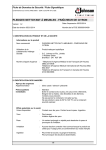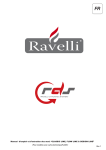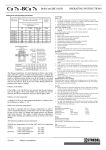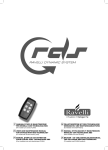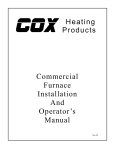Download SCAN-LINE95/100 OPERATING INSTRUCTIONS
Transcript
OPERATING INSTRUCTIONS SCAN-LINE95/100 www.heta.dk www.heta.dk UK 1 Congratulations on your new stove. of specifications and requirements in We are sure that you will be happy tended to ensure that the materials with your investment, especially if you used are of good quality, that the stove follow the advice and instructions we does not adversely affect the environhave put together in these operating ment, and hat it is economical to use. instructions. With your new stove you should have The Scan-Line 100 has been approved received the following: according to the EN 13240, DIN+ and a. Operating instructions NS 3058/3059. Approval means that consumers can b. Guarantee slip be sure, that the stove meets a range c. A stove glove INSTALLATION INSTRUCTIONS Safety clearances Stoves must always be installed in line with national and, if applicable, local regulations. It is important to abide by local regulations regarding setting up chimneys and connection to same. Therefore, always consult your local chimney sweep before installation, as you are personally responsible for ensuring that the applicable regulations have been met. Distance regulations A difference applies to installation next to flammable and non-flammable walls. If the wall is made of non-flammable material the stove can, in principle, be placed flush against it. However, we recommend leaving a gap of at least 5 cm to facilitate cleaning behind the stove. The minimum distances to flammable material are stated on the boiler plate and are listed in the table on page 7. Warning! A stove gets hot. (In excess of 90 degrees) Take care to ensure that children cannot come into contact with it. Important 2 1. Make sure there is adequate provision to sweep the chimney. 2. Make sure there is adequate ventilation to the room. 3. Please note that any extraction fans operating in the same room as the wood-burning stove can reduce the chimney draft – which may have an adverse effect on stove combustion properties. In addition, this may cause smoke to be emitted from the stove when the firing door is opened. 4. It must not be possible to cover any air vents. The floor It is essential to ensure that the floor surface can actually bear the weight of the stove and a top-mounted steel chimney, if applicable. The stove must stand on a nonflammable surface such as a steel floor plate or a brick or tile floor. The size of the nonflammable surface used to cover the floor area must match national and local regulations. The chimney connection The chimney opening must follow national and local regulations. However, the area of the opening should never be less than 175 cm2, which corresponds to a diameter of 150 mm. If a damper is fitted in the flue gas pipe, there must always be at least 20 cm2 of free passage, even when the damper is in its “closed” position. If local regulations permit, two contained fireplaces can be connected to the same chimney. However, you must abide by local regulations regarding the distance between the two connections. The woodburning stove must never be connected to chimneys that are also linked to a gasfired heater. An efficient stove makes high demand on chimney properties – so always have your local chimney sweep evaluate your chimney. Connection to a brick chimney Brick a thimble into the chimney and seat the flue gas pipe in this. The thimble and flue gas pipe must not penetrate the chimney opening itself, but must be flush with the inside of the chimney duct. Joins between brickwork, the thimble and flue gas pipe must be sealed with fireproof material and/or beading Connection to a steel chimney When fitting a connection from a topoutput stove directly to a steel chimney, we recommend fitting the chimney tube inside the flue gas spigot so that any soot and condensation drops into the stove itself rather than collecting on the exterior surface of the stove. For connections to chimneys that are run through ceilings, all national and local regulations regarding distance to flammable material must be followed. It is important that the chimney is fitted with roof support so that the top panel of the stove is not required to bear the entire weight of the chimney (exces- sive weight may cause damage on or noise from the stove). Draft conditions Poor draft may result in smoke being emitted from the stove when the door is opened. The minimum chimney draft to ensure satisfactory combustion in stoves of this kind is 13 PA. However, there will still be a risk of smoke emission if the firing door is opened during powerful firing. Flue gas temperature at nominal output for Panorama 273 and Panorama XL 266 is 20° C. Flue gas mass flow rate for Panorama is 6 g/sec and for Panorama XL 7.5g/ sec. The chimney draft is generated by the difference between the high temperature of the chimney and the low temperature of the fresh air. The length and insula-tion of the chimney, wind and weather conditions also have an effect on the ability of the chimney to generate appropriate under-pressure. If the stove has not been used in a while, check that the chimney and stove are not blocked with soot, bird nests, etc., before using it. Reduced draft can occur when: • • • • • • • The difference in temperature is too small – due to insufficient chimney insulation, for example. The outdoor temperature is too high – in summer, for example. No wind is blowing. The chimney is too low and sheltered. The chimney contains false air. The chimney and flue gas pipe are blocked. The house is too airtight (i.e. when there is an insufficient supply of 3 • fresh air). Poor smoke extraction (poor draft conditions) due to a cold chimney or bad weather conditions can be compensated for by increasing the airflow into the stove. Good draft occurs when: • • • • The difference in temperature between the chimney and outdoor air is high. The weather is fine. The wind is blowing strongly. The chimney is of the correct height: at least 4.00 m above the stove and free of the roof ridge. Combustion air flow The insert stove is approved as a room air-dependent insert stove in accordance with EN 13240. All the combustion air flow in the inset stove comes from the room in which it is fitted. However, by connecting a sealed air inlet to the insert stove’s air intake connectors, the stove can be supplied with external combustion air flow. In this respect, the following requirements must be met: • • • Only approved materials may be used from the ventilation unit to the air inlet vent. The air inlet vent must be fitted correctly and insulated to prevent formation of condensate. The cross section of the vent and grille must be at least 78 cm². If the vent leads out into the open air, please note that the grille must be fitted with suitable wind protection. There must be no risk that the grille can get clogged by leaves, etc. INSTRUCTIONS FOR USE First firing The stove has been treated with a heat-resistant coating which hardens at a temperature of approximately 250 ºC. This hardening process causes the production of smoke and malodorous fumes, so the room must be very well ventilated. During the first firing, which should be carried out using approximatly 1.5 kg. of wood, the stoking door must be left slightly open and must not be closed until the stove is cold. This is to prevent the sealing rope sticking to the stove. Fuel Your new stove is EN approved for firing with wood fuel. You must therefore only burn clean, dry wood in your stove. Never use your stove to burn drifwood, as this may contain a lot of salt which can damage both the stove 4 and the chimney. Similarly, you must not fire your stove with refuse, painted wood, pressure-impregnated wood or chipboard, as these materials can emit poisonous fumes and smoke. Correct firing using well seasoned wood provides optimal heat output and maximum economy. At the same time, correct firing prevents environmental damage in the form of smoke and emmissions and also reduces the risk of chimney fires. If the wood is wet and inadequately seasoned, a large proportion of the energy in the fuel will be used to vaporise the water, and this will all disappear up the chimney. Thus it is important to use dry, well seasoned wood, i.e. wood with a moisture content of no more than 18%. This is achieved by storing the wood for 1–2 years before use. Pieces of firewood with a diameter of more than 10 cm should be split before storing. The pieces of firewood should be of an appropriate length (approx. 30-40 cm) so that they can lie flat on the bed of embers. If you store your wood outdoors, it is best to cover it. Examples of fuel values of different woods Regulating the airflow To adjust combustion airflow, use the handle at the front under the door. Combustion air flow is fully open when the handle is as far as possible to the right. To close gradually, slide the handle to the left. Fig. 1 Fuel type / number of cubic metres per 1,000 litres of oil Wood kg/m3 Wood kg/m3 Beech 710 Alder 540 Ash 700 Scotch pine 520 Elm 690 Larch 520 Maple 660 Lime 510 Birch 620 Spruce 450 Mountain pine 600 Poplar 450 Willow 560 It is advised not to use very oil-containing woods like teak tree and mahogany, as this can cause damage to the glass. Heating value in wood You have to use about 2.4 kg normal wood to replace one litre of heating oil. All woods have almost the same heating value per kg, which is about 5.27 kW/hour for absolute dry wood. Wood with a moistness of 18% has a efficiency of about 4.18 kW/hour per kg, and one litre heating oil contains about 10 kW/hour. CO2 release At combustion 1000 litres of heating oil forms 3.171 tons CO2. As wood is a CO2 neutral heat/ energy source, you save the environment about 1.3 kg CO2 every time you have used 1 kg normal wood. Closed Open Lighting To ignite the fuel, use fire lighters, small paraffin ignition bags or small pieces of wood placed on the bottom grate. Place larger pieces of wood on top of this kindling material, at right angles to the firing, doors. Completely open the secondary air supply and leave the firing door ajar – i.e. approx. 1 cm open. Once the fire has taken a good hold of the fuel and the chimney has heated up (after about 10 min) close the firing door. We recommend that you burn the entire first firing with the secondary air supply fully open to make sure that the chimney is thoroughly heated. Adding fuel A fresh supply of fuel should normally be added while there is still a good layer of hot embers. Spread the embers over the base grate, most towards the front of the stove. Lay a single layer of wood fuel corresponding to about 2.3 kg over the embers, at right angles to the stove door. Turn handle into top position (max. combustion- airflow). Keep door ajar if necessary. (The door should not be left open but fuel will 5 ignite more quickly while the door is ajar.) The wood should ignite within a very short time (usually 1-3 minutes). If the door is ajar, close it as soon as the fuel is ignited. When the flames spread across the fuel stack, adjust the combustion airflow to the required level. Nominal output 9 KW, with the combustion air flow about 80 % open. When adding fuel, make sure that the fuel is not too tightly packed, as this will lead to poorer combustion and fuel inefficiency. Fuel must be under the level of the top row of air holes and inside the outermost air hole to each side. See figure 2. Fig. 2 condary/start-up air supply to smother the fire. Call the fire department. Optimal combustion For optimal combustion and heating, this stove is designed to provide an optimum mix of primary and secondary air (in these instructions, we call this combustion air). The stove provides excellent heating efficiency and the window is easy to maintain as the secondary air ‘flushes’ the surface of the glass. Note that the stove will, of course, blacken if the airflow is too low. If there is too little oxygen, there is a risk that the window, etc. will Blacken due to the formation of soot deposits. A combination of incorrect combustion and damp wood fuel can cause a heavy, sticky coat of soot to form, which may cause the door seal to tear off next time the door is opened. Risk of explosion Reduced burning The stove is well-suited to intermittent use. If you wish to operate the stove with reduced out-put, simply insert smaller volumes of wood at each firing, and apply a lower airflow. However, remember that the secondary combustion air supply must never be shut off completely during firing. It is important to keep a good bed of embers. Gentle heat is released when the fire settles - i.e. when the wood no longer generates flames and has been converted to glowing embers. Chimney fires In the event of a chimney fire – which often results from incorrect operation or protracted firing with moist wood – close the door and shut off the se6 After you add new fuel, it is very important that you do not leave the stove unattended until the wood is burning constantly. This will normally occur within 30 to 60 seconds. A risk of explosion can possibly arise if too much wood is placed in the stove. This may result in the production of large volumes of gas, and this gas can explode if the intake of primary and secondary air is insufficient. It is an advantage always to leave some ash lying in the bottom of the combstion chamber. Be careful when emptying the ashes. Hot embers can remain in the ash for a long time. Stove data table in accordance with EN 13240 testing Stove type Nominal fluegas temperature c° Smoke stub Fuel volume Draught min mm kg mbar Nominal output tested kW Actual efficiency % Distance to flamable materials in mm behind at the the stove sides Scan-Line 266 ø150 2.3 0.13 9 81 100 100 95 273 Ø150 1,9 0,13 6,5 80 150 The nominal output is the output to which the stove has been tested. The test was carried out with the combustion air 80%. 250 350 Distance to furnitures from the stove in mm Stove weight kg 1200 155 1100 145 OPERATIONAL PROBLEMS The chimney must be swept at least once a year, we recommend the use of a NACS (national association of chimney sweeps) registered chimney sweep. In the event of smoke or malodorous fumes being produced, you must first check to see whether the chimney is blocked. The chimney must, of course, always provide the minimum draught necessary to ensure that it is possible to regulate the fire. Please note, however, that chimney draft is dependent on the weather conditions. In high winds, the draft can become so powerful that it may be necessary to fit a damper in the flue gas pipe to regulate the draft. When cleaning the chimney, soot and other deposits may come to fall on the smoke plate. In cases where the wood burns too quickly, this may be due to excessive chimney draught. You should also check to make sure that the door seal and ashpan seal is intact and correctly fitting. If the stove it generating too little heat, this may be because you are firing with wet wood. In this case, much of the heating energy is used to dry the wood, resulting in poor heating economics and an increased risk of soot deposits in the chimney. MAINTENANCE The surface of the stove has been treated with heat-resistant paint. The stove should be cleaned with a damp cloth. Any damage to the surface in the form of chips or scratches can be repaired using touch-up paint, which is available in spray cans. Cleaning the glass Incorrect firing, for example using wet wood, can result in the viewing window becoming covered in soot. This soot can be easily and effectively removed by using proprietary stove glass cleaner. 7 GUARANTEE Heta stoves are subjected to stringent quality control procedures both throughout the production process and immediately before delivery to the dealer. Therefore, the stoves are guaranteed against defects in manufacturing FOR FIVE YEARS. This guarantee does not cover: Wearing parts/fragile parts such as: • The fire-proof bricks in the combustion chamber. • The smoke baffle • The glass • The sealing rope • The grate frame The stove is prepared for a fresh air intake 8 Damage resulting from incorrect use Transport costs in connection with repairs carried out under guarantee Installation/disassembly in connection with repairs carried out under guarantee Should you have cause to make a complaint, please quote our invoice no. Warning Any unauthorised modification of the stove and any use of non-original spares will void the guarantee. FITTING EXTERNAL AIR INLET - FROM BELOW 1. Fresh air set - item no. 1515-0013 2. Remove stones from combustion chamber 3. Remove the steel plate at the bottom of the combustion chamber. See figure 2 4. Remove all 4 screws from the damper and cover in the air chamber. See figure 3 5. Lift the damper (see figure 4) and place the ø100 connector on top. Turn all 3 locking pins 90° until the connector is secured. 6. When the ø100 connector is fitted to the damper, put the ring with the cord around down at the bottom. See figure 5. 7. Carefully replace the damper. Check that the damper rotates freely and is not obstructed when you move the handle from left to right. Finally, replace the cover alongside the damper down in the air chamber and tighten. 8. Replace the steel plate in the base of the combustion chamber before repositioning the stones. Fig. 1 Fig. 4 Fig. 2 Fig. 3 Fig. 5 9 CLEARING SOOT AFTER SWEEPING OR WHEN RENEWING STONES Note that it may be necessary to clean/vacuum the holes and air duct behind the rear stone. Sequence of removal - stones 1. Remove spark screen and vacuum any ash in the bottom. 2. Baffle: Lift and turn the baffle slightly to one side and carefully remove. 3. Side stones: Turn carefully away from the side of the combustion chamber 4. Rear stone: Lift the lower edge free of the base plate and then lift out. 5. Base stone: Lift upwards and backwards away from the front edge of the stove. 10 Baffle Side stone Rear stone Base stone REAR STONE The rear stone has been devided into two stones. They are kept together with a small fitting on the back side, which is pushed down into the grooves. SCAN-LINE 95/100 WITHOUT PEDESTAL Special conditions regarding Scan-Line 95/100 without pedestal Make sure that the distance from the lower edge of the door to the floor is minimum 350 mm. for Sl95 And 460 for Sl100 Please also read the part about the floor on page 2. Min.350/ 460 mm By permanent floor which has nonflammable surface (such as concrete or floor tiles) there is no demand to the distance. 11 TRANSPORTATION SAFETY DEVISE Regarding Scan-Line 100 on a turnable pedestal ! 14-03-2013 0037-1366 The screw must be removed before the stove is used/turned! 12












